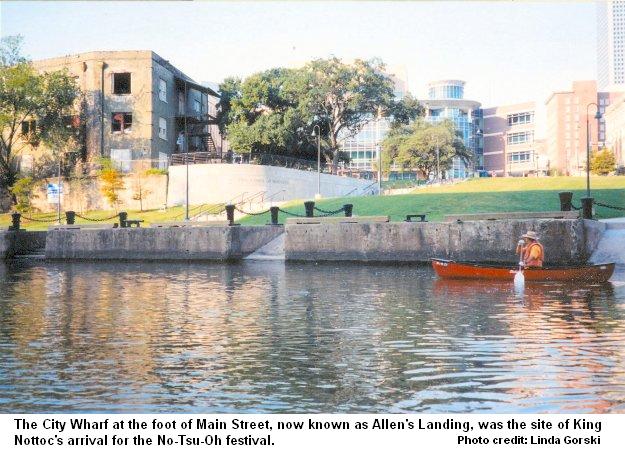 The
regal flotilla pulled up to the wharf at the foot of Main Street. After
the royal entourage exited to the landing amid the fanfare of the
occasion, King Nottoc stepped off the elegant vessel and strode up the
path to Commerce Avenue as the throngs of admirers cheered wildly and
thousands of Houstonians clogged the downtown streets. The celebration
of the No-Tsu-Oh carnival had begun.
The
regal flotilla pulled up to the wharf at the foot of Main Street. After
the royal entourage exited to the landing amid the fanfare of the
occasion, King Nottoc stepped off the elegant vessel and strode up the
path to Commerce Avenue as the throngs of admirers cheered wildly and
thousands of Houstonians clogged the downtown streets. The celebration
of the No-Tsu-Oh carnival had begun.Such was the scene for the beginning of the 1909 No-Tsu-Oh festival when Captain James A. Baker, Jr. was the king. But, the exuberant festivities were similar in each of the annual celebrations of No-Tsu-Oh from its beginnings in 1899 to the final carnival in 1915.
The No-Tsu-Oh festival (Houston spelled backwards) was a week long civic celebration of the importance of cotton to local economy. The Mardi Gras-style festival was presided over by King Nottoc (cotton spelled backwards) who usually was a prominent businessman chosen for the event. A local debutante was selected as the queen and her coronation at the grand ball was the highlight of the six days of parades and festivities.
The origins of the No-Tsu-Oh festival derive from an earlier event established in the mid-1880's by the local produce growers and wholesalers. This festival, called the Fruit, Flower and Vegetable Festival, was short lived. However, the concept had a certain appeal and the No-Tsu-Oh Association was organized to bring the No-Tsu-Oh Carnival to Houston in December, 1899. Later festivals were held in November.
A prominent event during the early No-Tsu-Oh festivals was the football game between the University of Texas and the Agricultural and Mechanical College of Texas. The rivalry of this game exists today as the annual contest between UT and Texas A&M.
The popularity of No-Tsu-Oh began to wane prior to the 1915 festival, and the carnival atmosphere of the festival seems to have degenerated to the level of "tin-horn parades and garrulous horseplay" as noted on the Houston Chronicle editorial page of November 18, 1915. The Chronicle begged: "Let it be our last 'Carnival.'"
With the arrival of World War I, the No-Tsu-Oh festival ceased and faded into history.